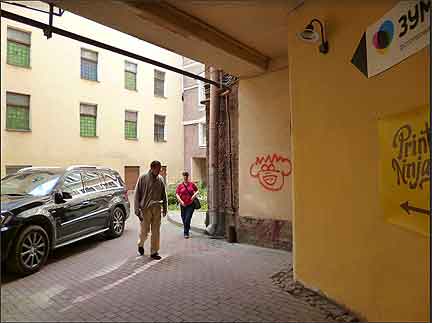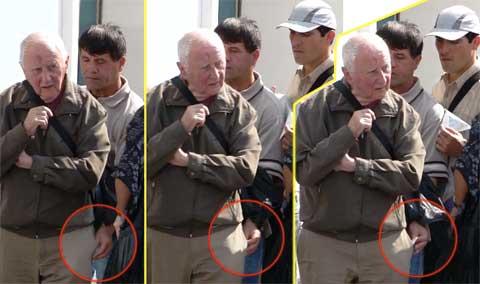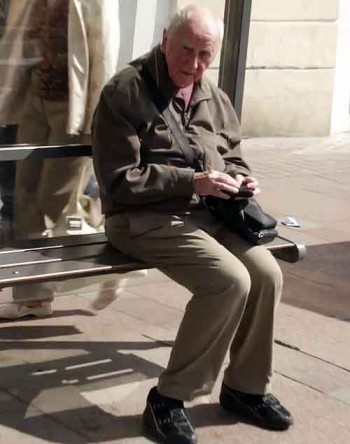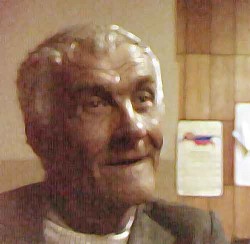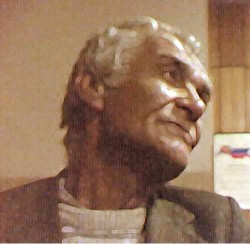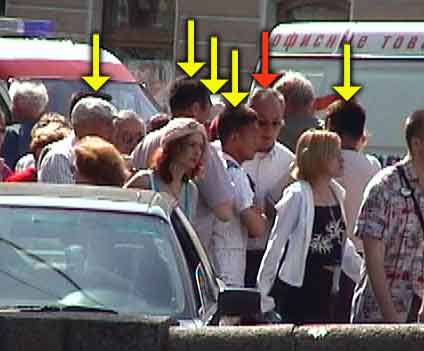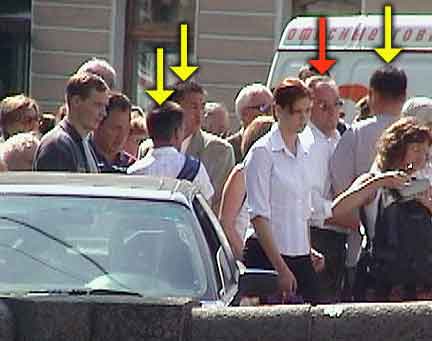A classic pickpocket maneuver in St. Petersburg, Russia, choreographed by a team and a spotter. Takes place within the tight confines of a cramped convenience store on Nevsky Prospekt.
Continue readingVodka and caviar in Russia
Vodka and caviar in Russia
Russian oligarchs suck billions of dollars from the national economy but leave lavish scraps to tease big bucks from high-end tourists. As trips to the region are being cancelled left and right, I’m looking back at my recent visit relying for sustenance on those extravagant scraps. Here’s to the past: dining like the oligarchs on vodka and caviar in Russia. A dis/tasteful extravaganza…


This was a favorite of mine (below): “Spirit of Russia Imperial Cocktail,” served at the Grand Hotel Europe in St. Petersburg. “A fine selection of the most famous varieties of caviar: beluga, ossetra, and red salmon caviar. Served on blinis with sour cream. Accompanied by a set of premium vodkas: Beluga, Tsarskaya Gold, and Russian Standard Platinum.

No, this was my favorite: “Egg in Egg.” An egg filled with truffle-scented scrambled egg, topped with ossetra caviar. Oh, yum! Also at the Grand Hotel Europe.

Outrageously delicious. Three varieties of caviar on silky, truffle-flavored scrambled egg.




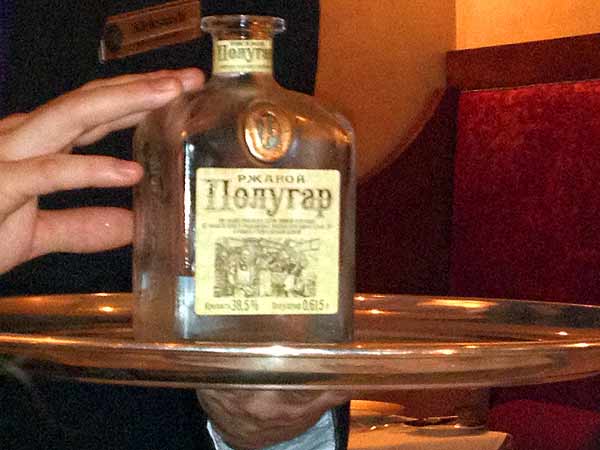
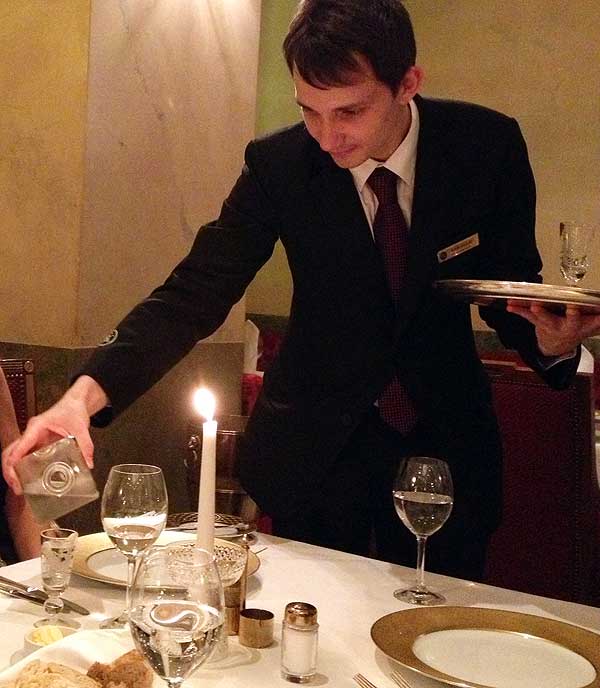
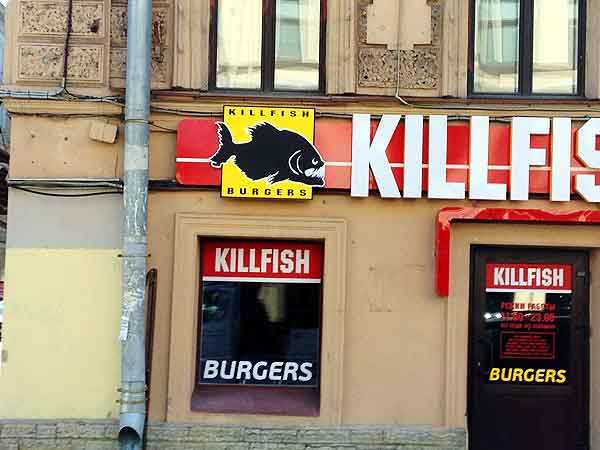
Why not read about the grittier side of Russia? Start with pickpockets in St. Petersburg.
Street crime in St. Petersburg, Russia
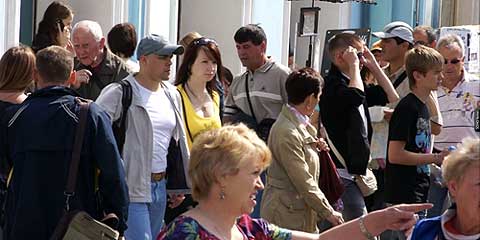
Prowling and preying with impunity, the pickpocket pair cared little about hiding their business. Yet none of the mighty swirling masses intent on going this way or that, paid them the least attention. Such is the state of street crime in St. Petersburg, Russia.
The thieves appeared aimless at first: bouncing around the intersection, crossing and recrossing the street, pausing to look into a window, only to turn and go back the way they’d just come. To anyone glancing at them, they blended into the crowd without suspicion.
Bob and I locked onto them the moment they appeared in front of us. (I’ll tell you why in the next post.) To watch the team’s activity for more than a minute is to understand their motive.
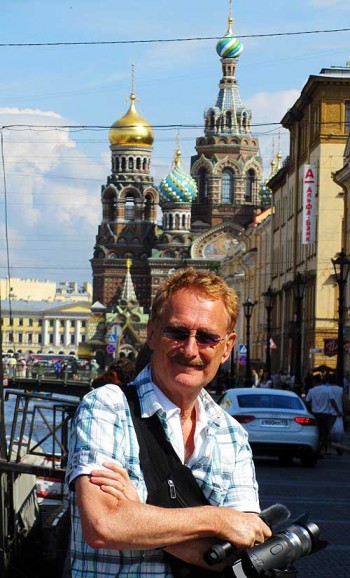
We happened to be in St. Petersburg, Russia, but it could have been anywhere. The location was perfect, and well-known to us from past thiefhunting exploits: on Nevsky Prospekt, the main drag, outside the area’s only Metro station. A very busy corner, human traffic ebbs and flows to the beat of the traffic lights and the comings and goings of underground trains.
A variety of police seem to patrol the area sporadically, strolling along in pairs, stopping briefly outside the Metro station doors. They have no apparent effect on the thieves we happened to be observing.
In years past, we’ve seen certain pickpockets operating day after day, month after month. Locals and expats come to recognize them, as of course the police do.
Street crime in St. Petersburg, Russia
Now locals tell us they see and hear of fewer thieves on the streets. Rather, the pickpockets prefer to work inside the Metro. Tour guides told us the thieves are more prevalent now inside the museums, in the Hermitage, and on the Navy ship Aurora; in other words, where the crowds are, where the tourists are.
Our observant friend who works at the art market on Nevsky Prospekt says the thieves stay on the move, never pausing. Indeed, that’s what we observed as we followed this brazen pair.
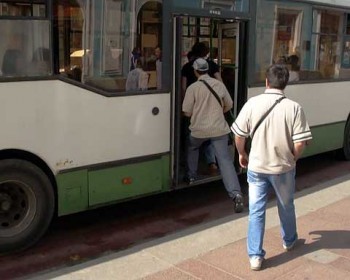
After they’d zigzagged around the area for about twenty minutes, halfheartedly hunting, I followed them down the street where they hopped onto a rather empty bus. If stealing aboard were their intent, they’d have waited for a crowded bus. In this case, they got on the bus simply to be transported away.
When they’d gone, I went back to my post outside the Canal Griboyedova Metro station. Sure enough, after ten minutes or so, the pair came sauntering back to the corner. This time they locked onto a mark, a stooped geezer whose shoulder bag dangled behind him.
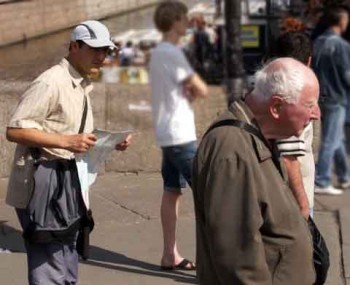
The two trailed the old man as he meandered, staying behind him, one to the left, one to the right. The mark moved erratically and paused often: to look in a window, to cross the street, to gaze along the canal toward the magnificent Church on the Spilled Blood. Each time the thieves got close behind him, they’d get into theft position: one of them would unfold a map and use it to shield the view.
The problem was, they were a team of only two. They lacked the vital third member, the blocker. A blocker would have stopped short in front of the mark, forcing him to stand still for a moment—just long enough for the pickpocket to do his thing. A proper pickpocket crew of at least three individuals choreographs its moves like a Russian ballet.
Without a blocker, the pair couldn’t control their mark. They had to rely on natural reasons for him to pause. Alternatively, they could try to work in motion, which is much more difficult.
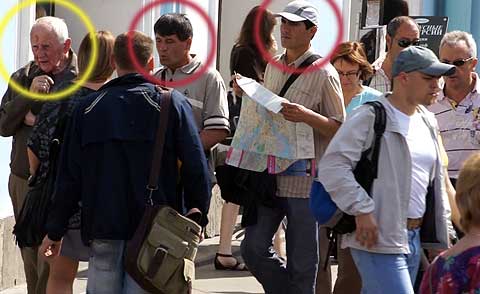
Finally, that’s exactly what they did. I was behind the thieves when they went for the pocket—not the hanging bag. Bob was some 20 yards in front of the threesome, but got a good shot with his new Sony NEX-VG10 video camera, thanks to its powerful long lens and stabilization.
In Bob’s footage, we see everything. The thieves’ great concentration, a hand in the pocket, the partner’s readiness. Then the extraction, the unfurling of the stolen handkerchief, the smooth passing of it to the partner. And through it all, the unsuspecting victim shuffles on.
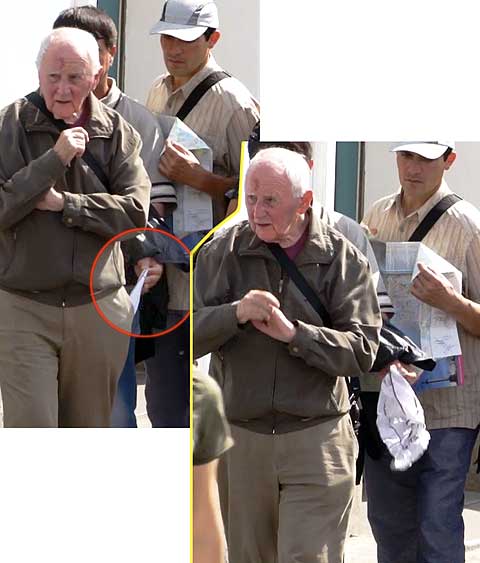
The thieves weren’t fazed by their lousy haul. They stayed right on their prey, attempting another hit on the same pocket. They must have seen or felt the weight of something hefty inside (by “fanning“), and it was clear that their victim was oblivious to them. So was all of mankind, as far as they were concerned. They operated as if invisible to the world.
Or as if they’d paid for the privilege of haunting this stretch of Nevsky Prospekt for this time period. We’d been told more than once over the past 13 years that pickpockets pay police for permission to work at a specific time and place. We have not confirmed that this system is still in effect but… old ways change slowly, if you know what I mean.
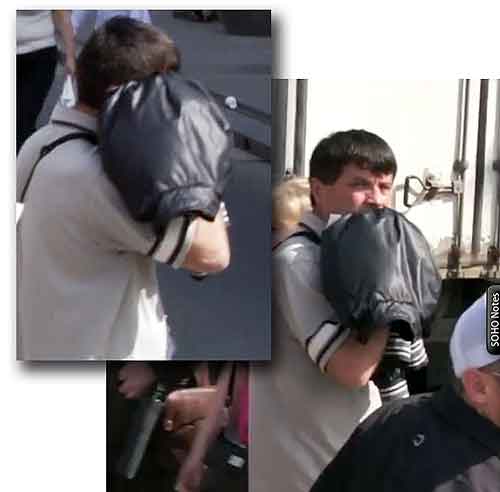
On previous thiefhunting expeditions in Russia, we’ve used hidden cameras, or at least unnoticeable ones. This time, Bob’s bulky Sony, held up to his eye and aimed directly at our quarry, made his interest obvious. One of the pair noticed and, when he crossed in front of Bob, hid his face with his jacket. Then he peeked: still filming?
The victim eventually wandered off and stood on the canal bridge until the pickpockets gave up on him. Still unaware of his followers, he trudged back down the block to the bus stop and sat on the bench. Perhaps he was aware of something amiss, because he began an inventory of his belongings, starting with his wallet, taken from the same pocket the handkerchief had been stolen from. Did he notice the handkerchief was gone? Was there something else stolen that we didn’t catch?
More on pickpockets in Russia:
Russian Rip-off: pickpockets and thugs
Russian gas-guzzler scam #3
Unlike the Russian gas scams in my previous two posts, this one is recent, perpetrated by Russians in America. They’d steal a car—say, a Mercedes—take it to a shop, and completely gut it. Then they’d abandon the still-pristine but empty body on the side of a road.
Eventually the shell of the car would be picked up and sold for pittance at auction. And there to buy it would be one of the Russian crew. The body came with a clean title after a legal purchase. And you know what happened next. The car went back to the shop where all its innards were replaced and a good-as-new Mercedes would be legally exported to Russia.
This was an easy scam. So easy that the crew got lazy and left one too many stripped-down bodies on the same road. And that’s how they were caught.
As told to me by an elderly Russian couple, along with this story, and this one.
Russian gas scam #2
Around the same time as Russian Gas Scam #1, a resident in one of those gigantic apartment buildings—I’ll call him Boris—found a way to warm his home for free throughout the frigid winters. Each apartment had its own coin-operated gas heater. For each coin dropped into the meter, the gas would come on for a set period of time to heat the home. Every month, the gas company would come collect the coins from the meter boxes.
Boris’s box was always empty; yet, his apartment was warm. It took a long time before the coin collector got suspicious, and even longer before the gas company showed up to ask questions. Finally, the gas company begged Boris for his secret, promising free gas for life if only he’d tell.
Simple, Boris said. He carved coins out of ice. They melted, evaporated, and left no evidence.
As told to me by an elderly Russian couple, along with this story, and an upcoming one.
Russian gas scam #1
In 50s Russia, men used to go through the enormous apartment buildings, knocking on thousands of apartment doors. They claimed to be from the gas company and needed to check each apartment’s air quality.
The men asked for an air sample, preferably in a clean glass bottle. Housewives were pleased to ensure the purity of the air their families breathed. In this way the scamsters collected thousands and thousands of milk bottles, which they turned in for deposit until they were caught.
As told to me by an elderly Russian couple, along with two upcoming stories.
How pickpockets use razor blades
A Close Shave, or, Honey, There’s a Hole in my Handbag
Archil Zantaradze keeps a razor blade in his mouth the way someone else might store a tired wad of gum. Gently curved against his upper palate, he can dislodge the blade with a bit of tongue suction and discreetly arm himself in an instant.
True, pickpockets, by our definition, are non-violent. The razor, actually half a blade, is meant to slice a pocket or a purse; never human flesh. The technique is a specialty of Zantaradze, St. Petersburg’s most notorious Georgian pickpocket, and peculiar to his compatriots.
Zantaradze perfected this dangerous practice while just a teenager. (I can imagine the manipulation easily: as a kid, I removed my retainer the same way. But I never worried about drawing blood!) He was taught by his own father, as all his brothers were. And before he ever even scraped a razor against his first soft whiskers, he could shoot the blade with awesome skill from its wet storage place to his soft palm. His dexterous tongue snaps as quickly as a frog’s and he catches the razor in his hand as neatly as a magician palms a card.
Zantaradze’s sleight of tongue is not unique among the criminal population of Russian Georgians. Those who aren’t taught at home learn in jail, where the razor blade is a vital commodity. Desperately creative, inmates find inconceivable functions for the simple object. Indeed, when attached to a short length of wire and pushed into a power outlet, the lowly blade miraculously becomes both a little heater and a water-boiler. And, “a skillful cut of veins may lead a tired prisoner if not to death, then into the relative comfort of a prison’s hospital bed,” my Russian journalist friend Vladimir explained. “Life accounts in prisons are also known to be settled with this small metal device. Not to mention the ordinary functions of the razor blade, like shaving or paper-cutting.”
Vasily Zhiglov, our St. Petersburg Police informant, arrested Zantaradze some months before my questions to him, and thereafter had ample opportunity to interview him. Lounging in prison, Zantaradze was unembarrassed but surprised that he had failed to bribe his way out. Officer Zhiglov acknowledged that not all policemen can resist this “easy-sounding temptation,” as the sum represents full or at least half of a policeman’s monthly wage. (The bargaining usually starts at 500 rubles—$25 at the time of this research.)
It was not without a certain pride that Zantaradze admitted to Zhiglov that he, along with at least four other Georgians, spent the summer of ’98 in France, “working” the streets and stadiums of cities hosting matches of the World Cup. Zantaradze maintained that a skilled thief could easily make three to five thousand U.S. dollars a day by extracting cash from the pockets and bags of the hordes of often-drunk soccer fans cruising the streets and shops of every hosting city. The French towns, unaccustomed to such crowds and crime, were unprepared and understaffed for the deluge.
Officer Zhiglov estimated that there were about 70 Russians, mostly from Moscow and St. Petersburg, who combined the pleasure of watching World Cup matches with the labor of cleaning out other fans’ bags and pockets. He said that before heading to “work” in a foreign country, a pickpocket would thoroughly study the criminal code of that country. “And one would certainly prefer to work in France or another European nation where the law is much softer on this particular crime than, say, in Arabic countries,” Zhiglov said. Each year Russia receives about a dozen of its returned citizens caught stealing abroad.
Igor Kudelya, Senior Lieutenant of the St. Petersburg pickpocket squad, said that on frosty winter days, when other pickpockets’ fingers “have frozen senseless,” the Georgian can be spotted warming up his fingers by exercising them with two or three small metal balls before entering a chosen work spot.
Excerpt from Travel Advisory: How to Avoid Thefts, Cons, and Street Scams
Chapter Five: Rip-offs: Introducing…The Opportunist
Promised pictures of thiefhunting in Russia
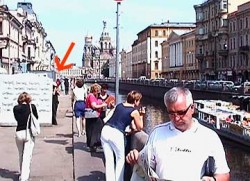
Were you waiting with bated breath for the promised pictures of the Russian ice cream seller and the stolen credit cards she retrieved from her rubbish bin? Were you trying to picture the pee-stained concrete slab I hid behind while filming the Mongolian thieves in St. Petersburg? If yes to either, you’re in luck. In my few days at home between trips, I’ve grabbed a few frames from the video and posted them to the story Bolshoi Bandits: more pickpockets in Russia.
![]()
Bolshoi Bandits: more pickpockets in Russia
The Bolshoi Bandits and the Crosswalk Czar
In which Bob Arno and his fancy accessory spy on the Russians.
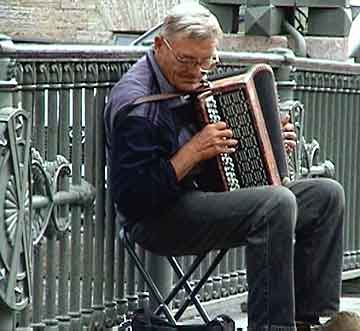
St. Petersburg, Russia— I was ensconced in my stake-out spot on the Canal Griboyedova across from the Gostiny Dvor Metro station; Bob was elsewhere. My position was excellent: close to the action, but the canal between my spot and the crime scene prevented my view from being blocked by passing people. It also had a massive, standing concrete slab, some sort of abandoned roadworks part, which I could duck behind when necessary. Leaded exhaust already lined my nasal passages, and fresh pee fumes rose from the slab. The location wasn’t perfect. I did enjoy the faint strains of accordion from a man squeezing one on the canal bridge half a block away.
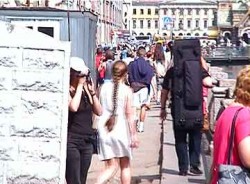
After filming alone for an hour or so, Bob passed behind me as if he didn’t know me and suggested I cross Nevsky Prospekt because the Mongolian pickpocket gang was at work in the crosswalk, out of my field of view. I did so, but felt exposed and nervous. I half hid behind a billboard and tried to film them, but the angle wasn’t good. A constant stream of pedestrians and traffic blocked my view of the corner. I was also afraid that, since they knew me, one of the gangsters would approach me from behind, or while I was looking through the camera’s view finder. After a while Bob came to get me again.
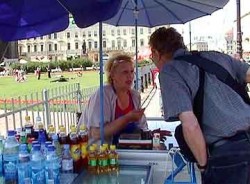
He brought me over to an ice cream cart on the corner in front of the Kazansky Cathedral. The proprietor, Katarina Pavlova, spoke French to Bob. She said she had noticed that he was observing the pickpockets, and that she had something to show him. She looked left and right before explaining that one of the thieves had walked past her stand and tossed something into her trash. Digging through the garbage, she retrieved a thick stack of credit cards, ID, and other wallet contents belonging to a 55-year-old French woman.
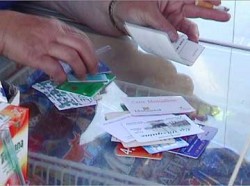
The ice cream seller said she felt it was safe enough to tell us only because this was her last day of work; she was retiring from the ice cream business and planned to stay out of the city. She pressed the plundered heap into Bob’s hand with a forced crooked smile. He should take it. For some reason, she felt it was right.
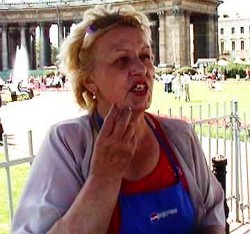
Â
So. Pickpockets were dumping ID and credit cards. This seemed to corroborate what other thieves and the police had told us: that the guys working the streets do not exploit credit cards. But what were we to do with the cards? Of course, we immediately thought, we’d try to return them to the victim. After all, they included a telephone number and address. But just as quickly, with a chill, we asked ourselves if this was a set-up. Can you imagine the shakedown? We’re accused of being pickpockets, searched, and found with a French woman’s documents. What would that cost in baksheesh? I imagined handcuffs; then beatings and prison and huge ransoms.
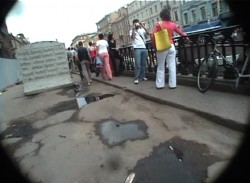
Bob took the cards.
I objected. So we compromised. We gave the cards back to the ice cream seller, then videotaped her handing them over to Bob and explaining how she had obtained them. Might not stand up in court, but it eased my mind. Eventually, we did try to phone the woman in France, but the number was no longer good. We put them into the mail and never heard of them again.
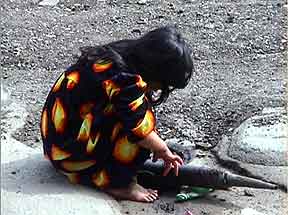
We wandered a couple blocks down, halfway between Nevsky Prospekt and the Church on the Spilled Blood, toward an internet cafe. We’d been inside it many times, and it was always empty except for the sour boy who took our coins. Wandering along, we paused in the oppressive heat to watch a tiny barefooted girl squatting in the street, spinning an old muffler.

With fine-tuned radar, she leapt to her feet as a man and woman strolled into view and ran to them as fast as her heavy velvet dress allowed. Her big brown eyes netted a bottle of water, which she appeared to take with delight. She went back to her muffler, only to rise again for the next couple, who tried to ignore her.
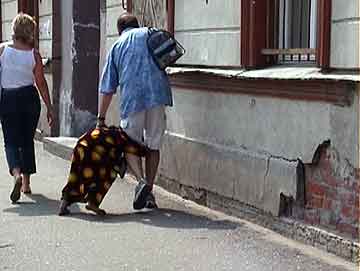
The tenacious little beggar latched onto the man’s leg and wouldn’t let go. When she fell to her knees, the man literally dragged her along the pavement.

One American dollar freed him. The girl admired her take, carefully folded the bill, and stuffed it into a small pouch that hung from her neck. We watched her until she ran to her mother, who sat on the ground with an infant a block away, leaning against the canal rail.
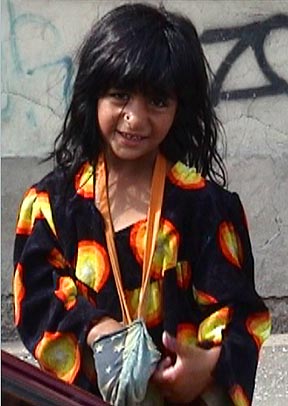
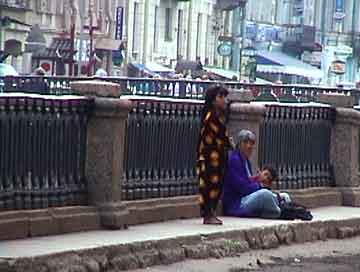
Late that night, we spoke with a group of Belgian tourists who said that they had been robbed the day before while coming out of the Metro station on Nevsky Prospekt. Three women were hit. One had her purse slashed with a blade and all contents were removed. Her arm had been across her purse. The cut was just under her forearm. The thief had planted his elbow in the woman’s stomach. The other woman had her fannypack opened. The pickpocket handed her passport back to her, indicating that it had been on the ground. I didn’t get the story of the third woman.
Andrey Umansky, a front desk manager at the Grand Hotel Europe, used to work at Baltic Tours, a tour bus operator. Every spring, before tourist season began, they’d pay the police, he said. The deal was that they’d use special signs affixed to buses and carried on sticks, which were meant to tell thieves to stay away from this group. And the police, he explained, made deals with the thieves in order to protect the groups that paid for protection.
There’s lots more.
Another day…
See Russian Rip-off, a five-part post with video.
Russian Rip-off: pickpockets and thugs, part 5 of 5
Pickpockets in St. Petersburg

St. Petersburg, a few weeks later—We loaded ourselves with video equipment this time, and headed straight for the Metro corner. Having spoken with the gang three weeks earlier, we were afraid to get too close. We wanted to observe them in action without being noticed. I found an excellent location just across the canal from the Metro entrance, a perfect stake-out spot with a convenient cement chunk I could hide behind when necessary. Bob wandered, undisguisable, wishing for a height reduction.
Instant gratification! (No, not Bob getting shorter.) First I noticed two of the gang leaning on the canal wall, watching the heavy flow of people going into and out of the Metro.

I recognized others loitering in the doorway and on the street corner. Most of them seemed to get or make frequent phone calls. They often disappeared from view, melting into the crowd, ducking into the station, or being obscured by traffic.
Suddenly, they’re off and running. I follow with my video camera. The victim doesn’t have a chance. Six gang members surround him. It’s impossible to see them all at any one moment, but on the video (see Part 2), you can see them dance around the mark like a Russian ballet. Two men maneuver themselves in front of him, impeding his progress. Four others are behind and beside him. Then, to buy more time, the largest of the team, in the gray t-shirt, spins around and shoves his weight against the victim’s chest and stomach, nearly doubling him over.
It was impossible to determine if anything had been taken. I had to choose who to follow with the camera and I chose to follow the thieves, who quickly dispersed, then regrouped. I don’t know how the victim reacted seconds later. He immediately left my field of vision.
I got another pursuit on film, but it ended behind an ice cream kiosk that blocked my view. I wasn’t far away, but I was stationary, with a canal in front of me. I got lots of shots of the thieves positioning themselves among the crowds crossing the street.
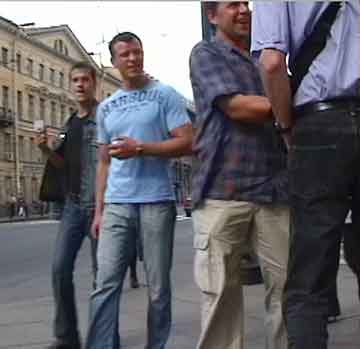
Meanwhile, Bob wandered through the danger zone. He watched other thieves display their well-practiced choreography. They also employed the Russian sandwich, with a dropped piece of paper, a bend, a block, and a partner’s pluck from behind.
Mohammed is fine. He’s recovered from his near-arrest and is friendly with us again. We didn’t dare ask him to interpret for us again. But we met a nice Russian woman at the black market who teaches English…
This is Part 5 of 5. Part 1 — Video in Part 2

